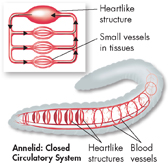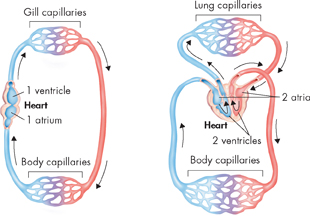
FIGURE 27–10 Closed Circulatory System Annelids, such as earthworms, and many more-complex animals have closed circulatory systems. Blood stays within the vessels of a closed circulatory system.
dClosed Circulatory Systems Many larger, more active invertebrates, including annelids and some mollusks, and all vertebrates have closed circulatory systems, such as the one shown in Figure 27–10.  In a closed circulatory system, blood circulates entirely within blood vessels that extend throughout the body. A heart or heartlike organ forces blood through these vessels. Nutrients and oxygen reach body tissues by diffusing across thin walls of capillaries, the smallest blood vessels. Blood that is completely contained within blood vessels can be pumped under higher pressure, and thus can be circulated more efficiently, than can blood in an open system.
In a closed circulatory system, blood circulates entirely within blood vessels that extend throughout the body. A heart or heartlike organ forces blood through these vessels. Nutrients and oxygen reach body tissues by diffusing across thin walls of capillaries, the smallest blood vessels. Blood that is completely contained within blood vessels can be pumped under higher pressure, and thus can be circulated more efficiently, than can blood in an open system.
Single- and Double-Loop Circulation
 How do the patterns of circulation in vertebrates compare?
How do the patterns of circulation in vertebrates compare?
As chordates evolved, they developed more-complex organ systems and more-efficient channels for internal transport. You can see two main types of circulatory systems of vertebrates in Figure 27–11.
Single-Loop Circulation  Most vertebrates with gills have a single-loop circulatory system with a single pump that forces blood around the body in one direction. In fishes, for example, the heart consists of two chambers: an atrium and a ventricle. The atrium (plural: atria) receives blood from the body. The ventricle then pumps blood out of the heart and to the gills. Oxygen-rich blood then travels from the gills to the rest of the body and returns, oxygen-poor, to the atrium.
Most vertebrates with gills have a single-loop circulatory system with a single pump that forces blood around the body in one direction. In fishes, for example, the heart consists of two chambers: an atrium and a ventricle. The atrium (plural: atria) receives blood from the body. The ventricle then pumps blood out of the heart and to the gills. Oxygen-rich blood then travels from the gills to the rest of the body and returns, oxygen-poor, to the atrium.
Double-Loop Circulation As terrestrial vertebrates evolved into larger and more active forms, their capillary networks became larger. Using a single pump to force blood through the entire system would have been increasingly difficult. This issue was avoided as the lineage of vertebrates that led to reptiles, birds, and mammals evolved.  Most vertebrates that use lungs for respiration have a double-loop, two-pump circulatory system.
Most vertebrates that use lungs for respiration have a double-loop, two-pump circulatory system.
BUILD Vocabulary
MULTIPLE MEANINGS The word atrium has different but parallel meanings in everyday usage and in biology. In everyday usage, it means a large entrance hall. In biology, it means a heart chamber through which blood from the body enters the heart.

FIGURE 27–11 Single- and Double-Loop Circulation Most vertebrates that use gills for respiration have a single-loop circulatory system that forces blood around the body in one direction (left). Vertebrates that use lungs have a double-loop system (right). (Note that in diagrams of animals' circulatory systems, blood vessels carrying oxygen-rich blood are red, while blood vessels carrying oxygen-poor blood are blue.)
d
Table of Contents
- Formulas and Equations
- Applying Formulas and Equations
- Mean, Median, and Mode
- Estimation
- Using Measurements in Calculations
- Effects of Measurement Errors
- Accuracy
- Precision
- Comparing Accuracy and Precision
- Significant Figures
- Calculating With Significant Figures
- Scientific Notation
- Calculating With Scientific Notation
- Dimensional Analysis
- Applying Dimensional Analysis




